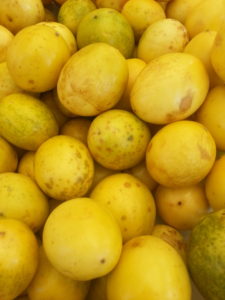Pomegranate

Pomegranate – Punica Granatum is gaining popularity in the culinary world. It’s uses in garnishes and juices are almost an every day scene around the culinary world now. But I just have a recent encounter of the fruit while I was in California. The in-laws have a tree and gave us the pomegranates as you see in the picture. I was curious how to eat it and they just break it open and take the seeds one by one and collect it. It was interesting but I got the hang of it but I ate it along the way, chewing and spitting the rest of the hard seeds. By the way, they call the outer juicy part of the seed “aril”.
The fruit of a pomegranate is loaded with ruby red succulent sweet seeds. The tree is a shrub that grows between 16 to 26 feet tall. It belongs to the Myrtle family.
Pomegranate originated in Iran and has been cultivated throughout the Mediterranean region and India. It was introduced into the Americas by Spanish settlers around the 17th century. Today it is widely cultivated throughout the Middle East and Africa. Grown for its fruits but pomegranate is also used as ornamental tree in parks and garden.
You can start growing tree from seeds, but hardwood cuttings is preferred propagation technique. Air layering is also another method of propagation. Seeds sometimes produces a different genetic cultivar.
I bought a dwarf variety of pomegranate. I understand that you can grow it like a bonsai which I am most interested in. I saw it have flowers but I did not see any fruit forming. Maybe it needs a certain type of bee to pollinate it. Anyways, I will just enjoy the fruits when it is in season from the Farmers market or grocery store in the months of September to February where they will be plentiful.
Nutrition wise, pomegranate seeds provides Vitamin C, Vitamin K, and folic acid. It is also a good source of dietary fiber and micro-nutrients if you eat the whole seeds.

